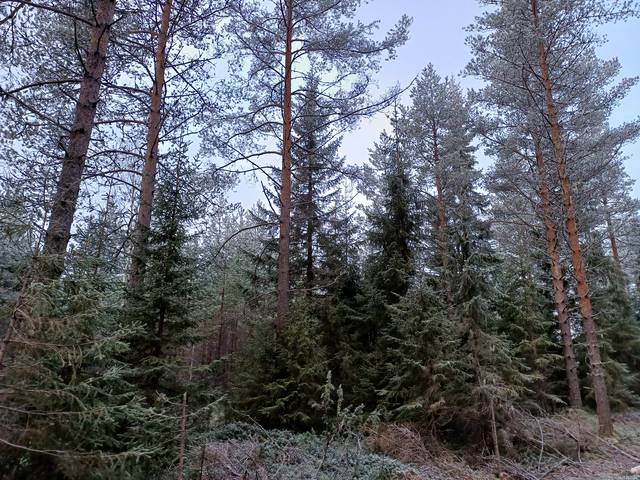Suojatiheikköjen jättäminen
- Inte tillgänglig på svenska
Sanasto
- Monimuotoisuuden rakennepiirre
Metsän monimuotoisuudelle tärkeitä rakennepiirteitä ovat vanhat ja kookkaat puut, järeät lahopuut sekä kasvatettavaan puustoon liittyvät ominaisuudet, kuten lehtipuusekoitus ja paikoittainen tiheä alikasvos.
Kirjallisuus
- Lilja S. & Kuuluvainen T. 2005. Structure of old Pinus sylvestris dominated forest stands along a geographic and human impact gradient in mid-boreal Fennoscandia. Silva Fennica vol. 39 no. 3 article id 377.
- Hiltunen, M., Kauhala, K. & Lindén, H. 2004. Habitat use of the mountain hare Lepus timidus in summer: the importance of different vegetation layers. Acta Theriologica 49: 479–490.
https://doi.org/10.1007/BF03192592(ulkoinen linkki) - Silvennoinen, H. 2017: Metsämaiseman kauneus ja metsänhoidon vaikutus koettuun maisemaan metsikkötasolla. Dissertationes Forestales 242: 1-86.
http://dx.doi.org/10.14214/df.242(ulkoinen linkki) - Brodie, L.C., & Harrington, C.A. 2020. Guide to variable-density thinning using skips and gaps. Gen. Tech. Rep. PNW-GTR-989. Portland, OR: U.S. Department of Agriculture, Forest Service, Pacific Northwest Research Station. 37 s.
https://www.govinfo.gov/content/pkg/GOVPUB-A13-PURL-gpo142518/pdf/GOVPUB-A13-PURL-gpo142518.pdf(ulkoinen linkki) - Tikkanen, O.-P., Matero, J., Mönkkönen, M., Juutinen, A. & Kouki, J. 2012. To thin or not to thin: bio-economic analysis of two alternative practices to increase amount of coarse woody debris in managed forests. European Journal of Forest Research 131: 1411–1422.
https://doi.org/10.1007/s10342-012-0607-8(ulkoinen linkki) - Melin, M., Mehtätalo, L., Miettinen, J., Tossavainen, S. & Packalen, P. 2016. Forest structure as a determinant of grouse brood occurrence - an analysis linking LiDAR data with presence/absence field data. Forest Ecology and Management 380: 202–211.
https://doi.org/10.1016/j.foreco.2016.09.007(ulkoinen linkki) - Klein, J., Thor, G., Low, M., ym. 2020. What is good for birds is not always good for lichens: Interactions between forest structure and species richness in managed boreal forests. Forest Ecology and Management 473: 118327.
https://doi.org/10.1016/j.foreco.2020.118327(ulkoinen linkki) - Helle, P., Jokimäki, J. & Lindén, H. 1990. Metsokukkojen elinympäristövalinta Pohjois-Suomessa – radiotelemetrinen tutkimus. Suomen Riista 36: 72–81.
- Gjerde, I. 1991. Cues in winter habitat selection by capercaillie. I. Habitat characteristics. Ornis Scandinavica 22: 197–204.
https://doi.org/10.2307/3676590(ulkoinen linkki) - Ludwig, G.X. 2007. Mechanisms of population declines in boreal forest grouse. Väitöskirja, Jyväskylän yliopisto. 48 s.
https://jyx.jyu.fi/bitstream/handle/123456789/13146/1/9789513928254.pdf(ulkoinen linkki) - Bradshaw, C.J.A. & Warkentin, I.G. 2015: Global estimates of boreal forest carbon stocks and flux. Global and Planetary Change 128: 24-30.
- Krankina, O.N. & Harmon, M.E. Dynamics of the dead wood carbon pool in northwestern Russian boreal forests. Water Air Soil Pollution. (1995) 82: 227.
https://doi-org.libproxy.helsinki.fi/10.1007/BF01182836(ulkoinen linkki) - Gustafsson, L. ym. 2012. Retention forestry to maintain multifunctional forests: A world perspective. BioScience, 62: 633–645.
https://doi.org/10.1525/bio.2012.62.7.6(ulkoinen linkki) - Lehtonen, A. et al. 2021. Maankäyttösektorin ilmastotoimenpiteet: Arvio päästövähennysmahdollisuuksista. Luonnonvara- ja biotalouden tutkimus 65/2021. Luonnonvarakeskus. Helsinki. 122 s.
- Mäkinen, H., Hynynen, J., Siitonen, J., Sievänen, R. 2006. Predicting the decomposition of scots pine, Norway spruce, and birch stems in Finland. Ecological Applications 16(5): 1865–1879.
- Holeksa, J., Zielonka, T., & Żywiec, M. 2008. Modeling the decay of coarse woody debris in a subalpine Norway spruce forest of the West Carpathians, Poland. Canadian Journal of Forest Research, 38(3), 415-428.
- Niemelä T, Wallenius T, Kotiranta H. 2002. The kelo tree, a vanishing substrate of specified wood-inhabiting fungi. Pol Bot J 47(2):91–101
- Pukkala, T., 2018. Carbon forestry is surprising. Forest Ecosystems 5, 11
https://forestecosyst.springeropen.com/articles/10.1186/s40663-018-0131-5(ulkoinen linkki) - Valkonen, S., Ruuska, J. & Siipilehto, J. 2001: Mäntysäästöpuut männyntaimikoissa – aukkoisuutta, kasvutappioita vai laatua? Metsätieteen aikakauskirja 1/2001: 55-59.
- Valkonen, S., Sirén, M. & Piri, T. 2010. Poiminta- ja pienaukkohakkuut – vaihtoehtoja avohakkuulle. Metsäkustannus Oy.
- Hosionaho, M. 2012: Säästöpuuryhmien vaikutus luontaisen taimiaineksen syntyyn uudistusaloilla. Pro gradu, Helsingin yliopisto.
https://www.theseus.fi/handle/10024/39585(ulkoinen linkki) - Palik M. 2003: Spatial distribution of overstorey retention influences resources and growth of longleaf pine seedlings. Ecol. Appl. 13: 674-686.
- Sterkenburg ym. 2019. The significance of retention trees for survival of ectomycorrhizal fungi in clear-cut Scots pine forests. J. Appl. Ecol. 56: 1367– 1378.
https://doi.org/10.1111/1365-2664.13363(ulkoinen linkki) - Korkama ym. 2006. Ectomycorrhizal community structure varies among Norway spruce (Picea abies) clones. New Phytologist, 171: 815–824.
https://doi.org/10.1111/j.1469-8137.2006.01786.x(ulkoinen linkki) - Outerbridge, R.A. & Trofymow, J.A. 2009: Forest management and maintenance of ectomycorrhizae: A case study of green tree retention in south-coastal British Columbia. J. Ecosyst. Manag. 10: 6.
- Stokland, J. N., Siitonen, J. & Jonsson, B. G. 2012. Biodiversity in dead wood. Cambridge, UK. Cambridge University Press. 509 s.
- Seibold ym. 2021: The contribution of insects to global forest deadwood decomposition. Nature.
https://doi.org/10.1038/s41586-021-03740-8(ulkoinen linkki)
